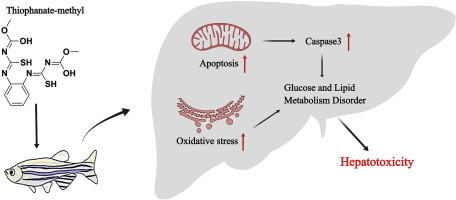当前位置:
X-MOL 学术
›
Chemosphere
›
论文详情
Our official English website, www.x-mol.net, welcomes your
feedback! (Note: you will need to create a separate account there.)
Thiophanate-methyl induces severe hepatotoxicity in zebrafish.
Chemosphere ( IF 8.1 ) Pub Date : 2020-01-21 , DOI: 10.1016/j.chemosphere.2020.125941 Kun Jia 1 , Bo Cheng 2 , Lirong Huang 3 , Juhua Xiao 4 , Zhonghui Bai 5 , Xinjun Liao 3 , Zigang Cao 3 , Tianzhu Shen 2 , Chunping Zhang 6 , Chengyu Hu 7 , Huiqiang Lu 3
Chemosphere ( IF 8.1 ) Pub Date : 2020-01-21 , DOI: 10.1016/j.chemosphere.2020.125941 Kun Jia 1 , Bo Cheng 2 , Lirong Huang 3 , Juhua Xiao 4 , Zhonghui Bai 5 , Xinjun Liao 3 , Zigang Cao 3 , Tianzhu Shen 2 , Chunping Zhang 6 , Chengyu Hu 7 , Huiqiang Lu 3
Affiliation

|
Thiophanate-methyl (TM) is widely used all over the world and is a typical example of pesticide residues, which can be detected in the soil, and even in vegetables and fruits. However, the molecular mechanisms underlying the hepatotoxicity of TM are not well understood. In this study, we utilized zebrafish to comprehensively evaluate the hepatotoxicity of TM and explore how the molecular mechanisms of hepatotoxicity are induced. The zebrafish larvae were exposed in 6.25, 12.5 and 25 mg/L TM from 72 to 144 hpf, while the adults were exposed in 2, 4 and 6 mg/L TM for 28 days. Here, we found that 12.5 and 25 mg/L TM induces specifically serious hepatotoxicity but not the toxicity of other organs in zebrafish larvae and adults. Moreover, it might triggered hepatotoxicity by activating the caspase-3 through apoptotic pathways and oxidative stress in zebrafish. Subsequently, this resulted in a metabolic imbalance in the zebrafish's liver. In conclusion, our results disclosed the fact that TM may induce severe hepatotoxicity by mediating activation of caspase-3 and oxidative stress in zebrafish.
中文翻译:

甲基硫氰酸甲酯在斑马鱼中引起严重的肝毒性。
甲基硫氰酸甲酯(TM)在世界各地广泛使用,是农药残留的典型例子,可在土壤中甚至在蔬菜和水果中检测到。然而,TM肝毒性的分子机制尚不清楚。在这项研究中,我们利用斑马鱼来全面评估TM的肝毒性,并探讨如何诱导肝毒性的分子机制。斑马鱼的幼虫分别在72至144 hpf的条件下暴露于6.25、12.5和25 mg / L TM中,成年动物暴露于2、4和6 mg / L TM中28天。在这里,我们发现12.5和25 mg / L TM会引起特别严重的肝毒性,但不会引起斑马鱼幼虫和成虫中其他器官的毒性。此外,它可能通过凋亡途径和斑马鱼中的氧化应激激活caspase-3来触发肝毒性。随后,这导致了斑马鱼肝脏中的代谢失衡。总之,我们的研究结果揭示了TM可能通过介导斑马鱼中caspase-3的活化和氧化应激而诱导严重的肝毒性。
更新日期:2020-01-22
中文翻译:

甲基硫氰酸甲酯在斑马鱼中引起严重的肝毒性。
甲基硫氰酸甲酯(TM)在世界各地广泛使用,是农药残留的典型例子,可在土壤中甚至在蔬菜和水果中检测到。然而,TM肝毒性的分子机制尚不清楚。在这项研究中,我们利用斑马鱼来全面评估TM的肝毒性,并探讨如何诱导肝毒性的分子机制。斑马鱼的幼虫分别在72至144 hpf的条件下暴露于6.25、12.5和25 mg / L TM中,成年动物暴露于2、4和6 mg / L TM中28天。在这里,我们发现12.5和25 mg / L TM会引起特别严重的肝毒性,但不会引起斑马鱼幼虫和成虫中其他器官的毒性。此外,它可能通过凋亡途径和斑马鱼中的氧化应激激活caspase-3来触发肝毒性。随后,这导致了斑马鱼肝脏中的代谢失衡。总之,我们的研究结果揭示了TM可能通过介导斑马鱼中caspase-3的活化和氧化应激而诱导严重的肝毒性。











































 京公网安备 11010802027423号
京公网安备 11010802027423号